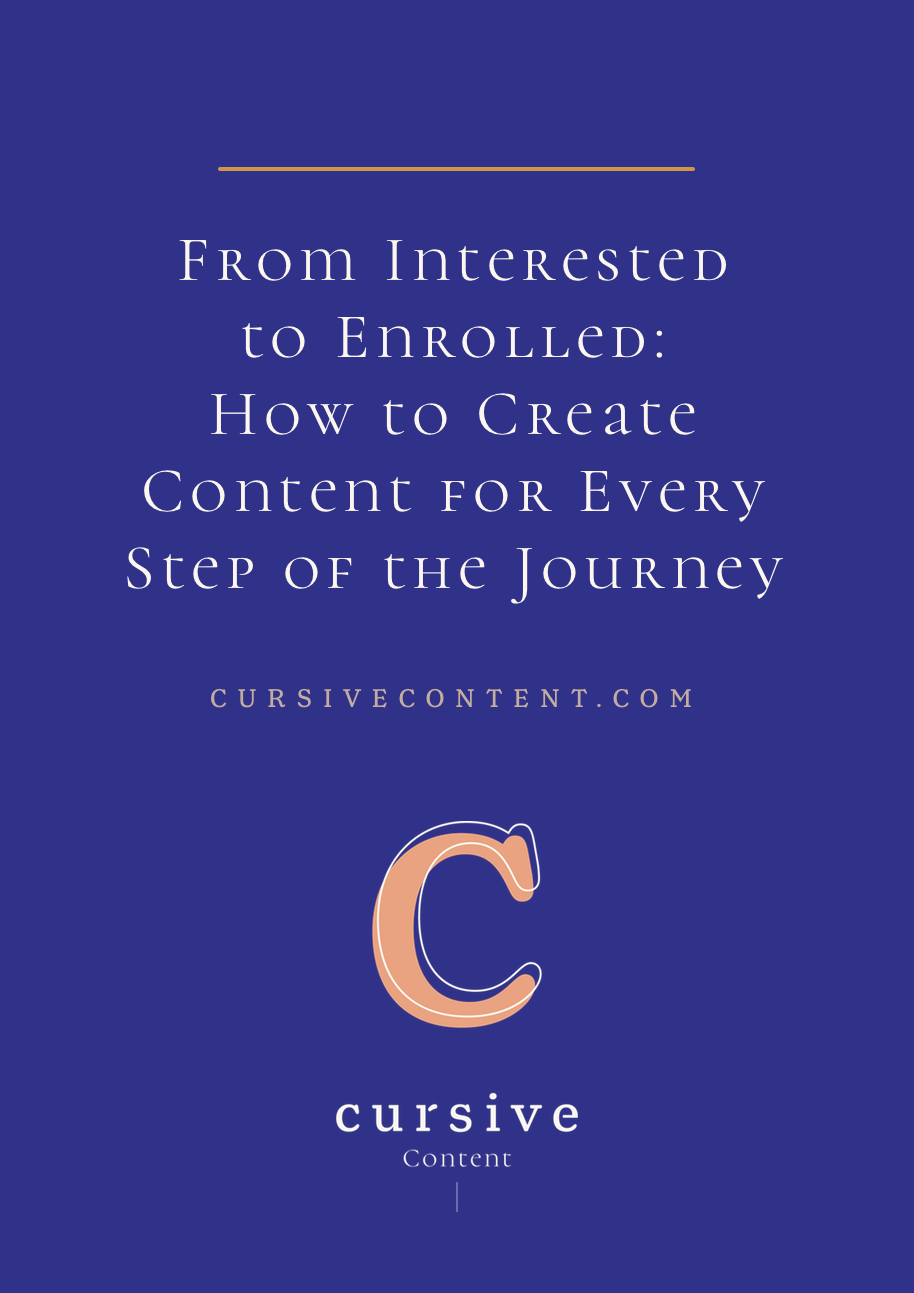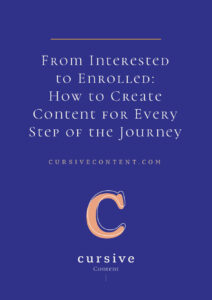From Interested to Enrolled: How to Create Content for Every Step of the Journey

When was the last time you really struggled to make a choice?
For me, it was a few hours ago. Despite being devoted to a giant cup of coffee each morning, I felt like tea today. But did I really? Coffee or tea? Coffee or tea? My decision-making skills were not up to par today.
Whether it’s making a simple choice like what to have for breakfast (I went with coffee) or something much more complex, like how to invest your finances, our days are filled with many decisions. Even as adults with plenty of life’s major choices under our belts, indecision still holds us captive.
Which makes it really easy to understand why prospective students might have a hard time making a school choice. And while you can’t make a student’s mind up for them, you can use content to guide students & families toward an informed decision.
Follow this 5-step exercise to go from discovering the content you need to creating a doable plan for implementation.
Step 1: Map out the journey
Goal: Understand the path students take from when they first find out about your school to submitting their application.
One of the most powerful ways schools can approach content is to think about it as a chance to speak to students at every stage of the decision-making process.
Those stages will be slightly different for every school, and may even vary a bit by department or program. For instance, if you are a higher education institution, the students interested in your graduate programs will go through a slightly different process than those interested in undergraduate programs. If you are a private high school with a strong focus on sports, the concerns of incoming athletes will be different than that of a traditional student.
In order to understand the typical path each type of student might take, map out the top-level steps students take in the most common situations.
Step 2: Ask questions about each stage
Goal: Use a brainstorming session to learn more about the students and families in each stage.
Once have the stages mapped out, it’s time to dig deeper into each stage. Let these questions guide a brainstorming session:
- What type of information do students need during this phase?
- What information do parents need?
- What are their concerns or other barriers?
- How can we increase interest in our school at this point?
- Do students/parents typically make a smooth transition from this stage to the next, or do they get stuck here? If so, why? If not, what helps them move along?
- What are the questions we typically hear from students/parents later in the process that we can answer now?
- Do we have any existing content that addresses these needs, concerns and barriers?
- If not, who are the people within our school that are best suited to address this topic, and how can we get them involved?
Write down everything as you brainstorm, and keep your answers handy for the the next step.
Step 3: Use your answers to create content topics
Goal: Generate content ideas that supports students and families at every stage and gently guides them forward.
Review your answers and think about how you can form the answers into content topics. For example, if during your brainstorming session you realized that new students often say they didn’t know you offered so many after-school clubs, jot down “variety of clubs & activities” as a content topic. Don’t worry about titles or formats, we’ll deal with those later. Just be as specific as possible about the topic you want to cover.
If you already have content on a particular topic, review it and make notes regarding how you can edit or expand that piece to better address the needs of your audience. If your existing content seems spot-on, note that, too, because we’ll come back to it in Step 5.
Step 4: Determine formats
Goal: Make the most of each content topic by choosing the format that will best convey the information.
Review each content idea you developed and think about the format that would best fit the topic. You might be able to address simple questions in a short blog post; a short explainer video might be the strongest way to explain a complex offering; an eBook might help paint a bigger picture for someone who knows little about your school.
Content format can make a huge impact. Don’t confine yourself.
Write down all great ideas, even those that sound too complex or costly for your capacity and budget. Creating well-rounded content that speaks to each type of student and each stage is a process, and this content plan might not be confined within a fiscal or calendar year. The important thing is to have a plan that addresses everything and allows you to see where you need to go (even if it takes a while to get there).
Step 5: Document your plan and proceed strategically.
Goal: Make a plan.
This is where all that brainstorming and analysis is consolidated into something much more tangible. Start by prioritizing content based on what you uncovered in your brainstorming session. For example, if you noticed a lack of content that addresses parent’s financial concerns, and you know finances are a big barrier to enrollment, focus on creating content that addresses that gap first.
Continue prioritizing in this way until you have a completed outline of the content you need to create.
When you’re done, you will have a comprehensive, prioritized plan of what your audience needs in order to feel confident about your school—and what you need to help boost inquiries and, ultimately, enrollment.
For more support as you begin to create the content outlined in your plan, check out:
- Your School’s Voice & Tone: What They Are, Why They Matter
- Beyond the Basics: Is Your School Creating Quality Content?
- How to Prepare Your School for “Generation Content” (Because It’s Not Just About Millennials Anymore)
And don’t forget to sign up for our weekly newsletter. We deliver one simple, actionable tip each week that helps school marketers strengthen their story.
MORE ARTICLES
-
 Clarity in 50 Words or Less: How to Write Your School’s One-Sentence Story
Clarity in 50 Words or Less: How to Write Your School’s One-Sentence Story -
 What Should Your School Do with Its Blog Now That AI Is Changing Search?
What Should Your School Do with Its Blog Now That AI Is Changing Search? -
 What Is Your Private School’s Bold & Unifying Big Promise?
What Is Your Private School’s Bold & Unifying Big Promise? -
 AI Writing Prompts to Power Private School Storytelling
AI Writing Prompts to Power Private School Storytelling -
 When to Outsource Your Private School Content Marketing to an Expert
When to Outsource Your Private School Content Marketing to an Expert -
 3 Unique Ways to Attract Dream Families with Content
3 Unique Ways to Attract Dream Families with Content -
 4 Quick & Easy Ways to Improve Your School’s Emails
4 Quick & Easy Ways to Improve Your School’s Emails -
 The Best Content Marketing Resources for Independent Schools
The Best Content Marketing Resources for Independent Schools


Sorry if I missed a post about this, but what advice would you offer for creating content for elementary school enrollment? We are obviously dealing with parents as the decision makers and not students.
Hi Audrey! I think the most important thing is to create content that addresses your prospective parents’ wants, needs, concerns, and challenges at each stage of their decision-making process — and to do that, you need to deeply understand your dream families. There are a few posts I would suggest that will help: this one on Audience-First School Storytelling, this one on Lead Generation, and this one on Conversion Copywriting. But if you have additional specific questions, let me know — or send me an email using the Contact form!